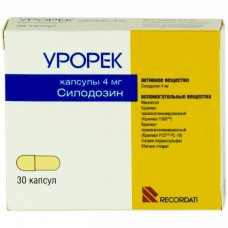Expiration date: 09/2027
Structure and Composition:
The capsules. One capsule contains active substance:
4 or 8 mg silodosin
Excipients: Mannitol - 132.4 / 264.8 mg pregelatinized starch (Starch 1500 ™) - 9/18 mg pregelatinized starch (Starch PCS ™ PC-10) - 26/52 mg of sodium lauryl sulfate - 1.8 / 3.6 mg magnesium stearate - 1.8 / 3.6 mg
Capsule: Gelatin - 47.434 / 98 mg of titanium dioxide - 0.48 / 2 mg dye iron oxide yellow (E172) - 0.086 mg
in packs contour of cellular PVC / PVDC / aluminum foil for 5 or 10 pieces. In the paper cartons 1, 2, 3, 5, 9 or 10 packs contour cell.
Description pharmaceutical form:
4 mg capsule: gelatin hard, yellow, size 3.
8 mg capsules: Gelatin hard, white size 0.
Capsule contents: crystalline or amorphous powder, white to light yellow color.
Pharmacokinetics:
When administered silodosin is well absorbed. The absolute bioavailability is 32%. Food reduces Cmax approximately 30%, increasing the Tmax of about 1 hour, and has minimal effect on AUC. Cmax - (87 ± 51) mg / mL, Tmax - 2,5 h, the mean concentration in urine (433 ± 286) ng / mL.
Vd silodosin is 0.81 l / kg and binding to plasma proteins - 96.6%. The binding of silodosin carbamoylglucuronide protein plaza is 91%.
Silodosin metabolized via glucuronidation (with UGT2B7), involving alcohol dehydrogenase and aldehyde dehydrogenase, oxidative pathways, mainly involving CYP3A4. The main active metabolite in plasma carbamoylglucuronide (KMD-3213G) reaches plasma concentrations of 4 times greater than the silodosin. Silodosin does not have the potential to induce or inhibit cytochrome P450 isoenzymes.
33.5% of silodosin eliminated via the kidneys and 54.9% through the intestines. Silodosin clearance is approximately 23.1 l / h. Silodosin is excreted mainly as metabolites, and in very small quantities - unchanged in the urine. T1 / 2 and silodosin is silodosin carbamoylglucuronide 11 and 18 hours, respectively.
Different groups of patients
Elderly. Pharmacokinetics and metabolites silodosin not substantially depend on age. The clearance of silodosin is not changed in patients older than 75 years.
With impaired hepatic function. In patients with moderate hepatic impairment (7-9 points on a scale Child-Pugh), the pharmacokinetics of silodosin was not significantly changed. In patients with severe hepatic impairment the pharmacokinetics of silodosin was not investigated.
With impaired renal function. For patients with moderate renal impairment did not require any dose reduction. For patients with severe renal impairment is not recommended the appointment of silodosin.
Description of the pharmacological actions:
Silodosin, a highly selective competitive antagonist & alpha1A-adrenoceptor blocking postsynaptic & alpha1A-adrenergic receptors located in the smooth muscle of the prostate, bladder neck and prostatic urethra. It lowers the tone of smooth muscles of the prostate, bladder neck and prostatic urethra, improving the flow of urine. Symptoms of obstruction and irritation at the same time decreasing associated with benign prostatic hyperplasia. Affinity for & alpha1A-adrenoceptors located in the bladder 162 times superior to its ability to interact with & alpha1B-adrenoceptors are located in vascular smooth muscle. Due to the high selectivity, it does not cause a clinically significant reduction in blood pressure in patients with initially normal BP.
Indications:
Benign prostatic hyperplasia.
Contraindications:
- hypersensitivity to active substance or any of the auxiliary components or intolerances
- Children under 18 years
- severe renal impairment (Cl creatinine <30 ml / min)
- severe hepatic insufficiency (insufficient clinical data).
Precautions: mild to moderate renal insufficiency (Cl creatinine 30-50 ml / min).
Application of pregnancy and breastfeeding:
Silodosin is only for men.
Side effect:
Adverse reactions frequency indication given below: very common (& ge1 / 10) are often (& ge1 / 100, <1/10), uncommon (& ge1 / 1000, <1/100), rarely (& ge1 / 10,000, <1/1000) Frequency not known (available data do not allow us to determine the frequency).
From the nervous system: often - dizziness frequency is unknown - syncope.
From the CCC: often - orthostatic hypotension.
With the respiratory system: often - nasal congestion.
On the part of the digestive tract: often - diarrhea, rarely - nausea, dry mouth.
Reproductive system: very often - retrograde ejaculation, anejaculation infrequently - decreased libido, erectile dysfunction.
Intraoperative cider: the frequency is unknown - intraoperative iris syndrome sagging during cataract surgery.
Drug Interactions:
Do not mix with other alpha-blockers & because of the possible potentiation of the action.
The combined use of inhibitors of isoenzyme CYP3A4 (ketoconazole, clarithromycin, itraconazole, ritonavir) is not, as recommended silodosin increases the concentration in plasma.
Phosphodiesterase-5 inhibitors (sildenafil, tadalafil), a joint application may increase the risk of dizziness.
Antihypertensive drugs - & beta-blockers, calcium antagonists, drugs acting on the RAAS, diuretics - a joint application enhance orthostatic hypotension.
Dosage and administration:
Inside.
The recommended dose - 8 mg once simultaneously with a meal, preferably in the same time. It is necessary to swallow the capsule whole, preferably a glass of water.
For patients with moderate renal insufficiency (Cl 30-50 ml / min creatinine) is recommended during the 1st week of taking the initial dose of 4 mg / day, with a good individual tolerance then the dose can be increased to 8 mg / day.
Overdose:
Symptoms: marked reduction of blood pressure, compensatory tachycardia.
Treatment: gastric lavage, activated charcoal or osmotic laxatives, symptomatic therapy aimed at increasing the BCC, vasoconstrictor drugs monitoring of renal function. Dialysis is ineffective due to heavy drug binding to plasma proteins.
Precautionary measures:
As with other alpha1-blockers & the treatment of silodosin may be a decrease in blood pressure, orthostatic hypotension. At the first signs of orthostatic hypotension (dizziness, weakness), the patient should sit or lie down and remain in that position for as long as the symptoms of orthostatic hypotension disappear.
Because benign prostatic hyperplasia and prostate cancer have similar symptoms and can develop together, patients with suspected benign prostatic hyperplasia necessary examination to exclude prostate cancer before prescribing the drug.
Treatment with Urorec reduces the allocated quantity of semen that can affect male fertility. This effect disappears after discontinuation of the drug Urorek.
Patients taking or taking blockers & alpha1-during cataract surgery may occur sagging iris syndrome, which can lead to complications during surgery. Discontinuation of treatment should be & alpha1-blocker 1-2 weeks prior to the operation. Patients receiving cataract surgery, it is not recommended to start treatment with Urorek.
Effects on ability to drive or to perform work requiring higher rate of physical and mental reactions. There has been no studies of the effect on the ability to drive vehicles and equipment. However, patients should be informed of the possible manifestations of the symptoms associated with orthostatic hypotension (eg dizziness), as well as to warn that one should refrain from driving vehicles and equipment to determine the individual tolerance of the drug Urorec patient.



